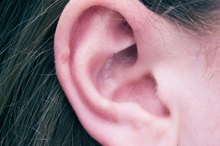How to Unplug Your Ears When You're Sick
Plugged ears may occur as a result of colds, infections or allergies. This symptom is related to fluid buildup in your eustachian tubes -- the tubes that connect your middle ear with the back of your nose and upper throat. This fluid buildup causes feelings of ear pressure, pain and discomfort, and may also lead to ringing in the ear, dizziness and hearing impairment. While there are some temporary fixes to plugged ears, to resolve this symptom, you'll need to manage the underlying cause.
If you are experiencing serious medical symptoms, seek emergency treatment immediately.
For immediate relief, try to unplug your ears by yawning, swallowing or chewing gum. Sucking on hard candy or lozenges may also help. This jaw movement may open your eustachian tubes and relieve pressure and discomfort 1. Other ways mild ear blockage can be improved is by moving the jaw forward, then side to side. If you think your baby has plugged ears, try giving her a pacifier or bottle.
Relief From Ear Congestion
Learn More
Another strategy to unplug your ears is to pinch your nostrils while breathing out with your mouth closed. If this doesn’t work, try to thrust your jaw upward while tilting your head back. If you hear a popping noise, you know this was at least temporarily successful.
If plugged ears are due to a cold or allergies, this symptom may be alleviated by managing the congestion and mucus buildup. Try using a humidifier in your bedroom at night, or use a saline nasal spray to moisten the nasal passages. Another strategy to unplug your ears is to sleep in a semi-upright position to facilitate draining of your sinuses and nasal passages. Prop your head up with several pillows, or sleep in a chair to keep your ears unplugged.
How to Relieve Pressure in the Ears From Sinus Drainage
Learn More
If you have congestion caused by an upper respiratory infection, an over-the-counter (OTC) decongestant may help. If your plugged ears are due to allergies, an OTC antihistamine may alleviate congestion and improve your symptoms 3. Prescription-strength medications and nasal steroids may be necessary for severe symptoms.
Tips
There are many tips and ideas to help unplug your ears, but there is little research to support the effectiveness of any one intervention, according to a July 2014 article in “Health Technology Assessment.” Since most upper respiratory infections do not need prescription drug therapy, trying various strategies to improve your symptoms can make you more comfortable as you recover. However, call your doctor if your symptoms are severe, or if you have ear or face pain, or if your symptoms have lasted more than 2 weeks. Not seeking treatment can delay important care to prevent hearing loss or ear damage from a severe infection. If you have been prescribed medications such as nasal sprays, inhalers or antibiotics, take these as directed to help control your symptoms. Also, be sure to take the entire course of your antibiotics, even if you begin to feel better before you finish treatment.
Warnings
Ear candles are sometimes recommended to treat plugged ears. This home remedy uses a hollow fabric tube soaked in paraffin or wax. As the person is lying on his side, the candle is placed on the outer ear and lit. This treatment is claimed to create suction and pull wax out of the ear canal. However, there is no quality evidence this treatment works, according to the Food and Drug Administration, and there are risks associated with this home remedy including burns and fire hazards.
Related Articles
References
- Health Technology Assessment: Interventions for Adult Eustachian Tube Dysfunction: A Systematic Review
- American Academy of Family Physicians: Eustachian Tube Dysfunction
- Earwax and Care. American Academy of Otolaryngology—Head and Neck Surgery. http://www.entnet.org/content/earwax-and-care.
- Ears and Altitude. American Academy of Otolaryngology—Head and Neck Surgery. http://www.entnet.org/content/ears-and-altitude.
- Trojanowska A, Drop A, Trojanowski P, Rosińska-bogusiewicz K, Klatka J, Bobek-billewicz B. External and middle ear diseases: radiological diagnosis based on clinical signs and symptoms. Insights Imaging. 2012;3(1):33-48. doi:10.1007/s13244-011-0126-z
- Teschner M. Evidence and evidence gaps in the treatment of Eustachian tube dysfunction and otitis media. GMS Curr Top Otorhinolaryngol Head Neck Surg. 2016;15:Doc05. doi:10.3205/cto000132
- Ear infections. Paediatr Child Health. 2009;14(7):465-8.
- Minovi A, Dazert S. Diseases of the middle ear in childhood. GMS Curr Top Otorhinolaryngol Head Neck Surg. 2014;13:Doc11. doi:10.3205/cto000114
- Hamilton-farrell M, Bhattacharyya A. Barotrauma. Injury. 2004;35(4):359-70. doi:10.1016/j.injury.2003.08.020
- Mcdonald MH, Hoffman MR, Gentry LR, Jiang JJ. New insights into mechanism of Eustachian tube ventilation based on cine computed tomography images. Eur Arch Otorhinolaryngol. 2012;269(8):1901-7. doi:10.1007/s00405-011-1829-y
- Lima MA, Farage L, Cury MC, Bahamad F. Update on middle ear barotrauma after hyperbaric oxygen therapy-insights on pathophysiology. Int Arch Otorhinolaryngol. 2014;18(2):204-9. doi:10.1055/s-0034-1366974
- Air travel and children's health issues. Paediatr Child Health. 2007;12(1):45-59.
- Loveman E, Gospodarevskaya E, Clegg A, et al. Ear wax removal interventions: a systematic review and economic evaluation. Br J Gen Pract. 2011;61(591):e680-3. doi:10.3399/bjgp11X601497
- Earwax and Care. American Academy of Otolaryngology—Head and Neck Surgery.
- Ears and Altitude. American Academy of Otolaryngology—Head and Neck Surgery.
- Diacova S, McDonald TJ, Ababii I. Clinical, functional, and surgical findings in chronic bilateral otitis media with effusion in childhood. Ear Nose Throat J. 2016 Aug;95(8):E31-7.
Writer Bio
Sandra Ketcham has nearly two decades of experience writing and editing for major websites and magazines. Her work appears in numerous web and print publications, including "The Atlanta Journal-Constitution," "The Tampa Bay Times," Visit Florida, "USA Today," AOL's Gadling and "Kraze Magazine."









